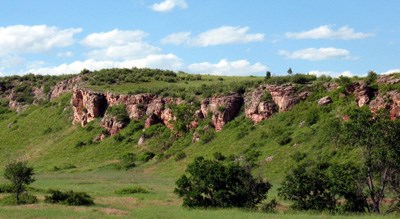Last updated: November 6, 2017
Article
Bison Bellows: Indigenous Hunting Practices

NPS Photo/Tom Farrell
Imagine crouching in the grass with a bison hide on your back while massive 2,000 pound animals graze a few feet from you. Moments later, you bellow like a stressed calf, wanting the herd to follow the noise. You continue to do until you are close to a cliff and then you start running as fast as you can towards the cliff while a herd of 40 bison stampede behind you. While this scene would never occur today, it would have a thousand years ago when Plains Indians hunted bison. Long before the acquisition of the horse, Plains Indians hunted bison on foot. For the Plains Indians, hunting was a way of life and they developed numerous solitary and communal hunting techniques. The buffalo jump and the buffalo impound commonly represent two primary group hunting methods used by the Plains Indians. It is important to note that the specific hunting strategies and techniques differed slightly depending on the tribe and geography.
The buffalo jump signifies a communal hunting method that provided enormous rewards. A buffalo jump entailed luring a herd of bison over a cliff or high hill causing them to fall to their death. To entice the bison to the jump site, a young man would disguise himself with bison hides to act as a decoy and would approach the herd mimicking bison behavior. This decoy position was an honor and usually appointed to the fastest runner. He would then start to make distressed calf calls, urging the herd to begin moving toward the noise and the direction of the kill site. While the decoy continued to lure the herd in the correct direction, other runners dressed as wolves would appear behind the herd to create a sense of danger. The runners would fan out into a V-shape formation waving blankets and guide the panicked animals off a steep slope. The bison would fall off the sides, one on top of the other. Although these buffalo jumps were incredibly dangerous, the rewards were magnificent. If 50 bison fell off the buffalo jump, it yielded roughly 11,000-20,000 pounds of meat!
With the same skills and courage as the buffalo jumps required, Plains Indians would lure bison into a timber corral if no cliff or steep hill was present. This type of hunting method required a "buffalo impound." Using similar techniques to those used in a buffalo jump, a herd of bison would be lured into a wooden impound and killed with bows and arrows. Hunters would create a wall about 10-15 feet high as well as a 100-yard chute into the unit. The hunters would drive the herd to the chute by slapping their robes against the ground. Once the herd was inside, they would be shot with arrows.
These two communal hunting methods required skill, courage, teamwork, and dedication. Often entire tribes would help with the hunt. With extreme cooperation, successful jumps could feed, clothe, and provide resources to entire tribes for extended periods of time. The tribes would use every part of the animal, whether it was the bones to make tools or the hair to make rope. Without communal hunting, killing a bison or a herd of bison could often be extremely dangerous and often unsuccessful for an individual hunter.
